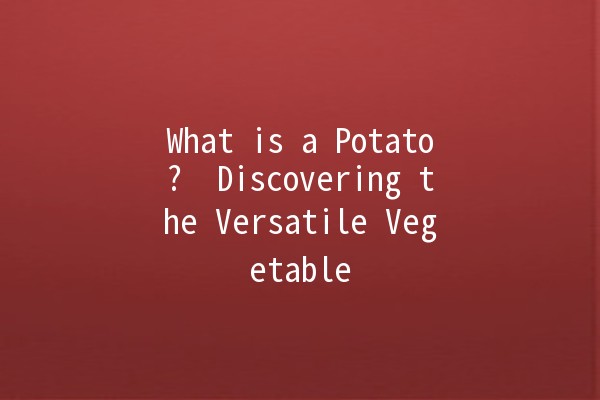Potatoes are one of the most versatile and beloved vegetables around the globe. Often mistaken as a mere side dish to complement our meals, they offer a wealth of possibilities when it comes to flavors, textures, and nutritional benefits. In this article, we will delve deep into the fascinating world of potatoes, exploring their history, types, health benefits, cooking methods, and ways to elevate your cooking with this humble ingredient.
The History of Potatoes

The potato (Solanum tuberosum) hails from the Andean region of South America, specifically modernday Peru and northwest Bolivia. It was cultivated by indigenous peoples over 7,000 years ago and was later introduced to Europe in the late 16th century by Spanish explorers. The potato quickly became a staple in many diets across Europe due to its adaptability and nutritional value.
By the 19th century, the potato was widely accepted and formed the basis of the diet in many countries, notably in Ireland. Unfortunately, the reliance on this crop also had dire consequences during the Great Famine of 18451849, when a potato blight led to mass starvation and social upheaval. Today, potatoes continue to be a crucial crop, with China and India leading global production.
Types of Potatoes
There are over 4,000 varieties of potatoes, each with its unique flavor, texture, and best uses in cooking. Here's a brief overview of the most commonly used types:
Nutritional Benefits of Potatoes
Potatoes are often underestimated when it comes to their nutritional value. Here are some key health benefits:
Cooking Techniques for Potatoes
Potatoes can be prepared in myriad ways, each technique bringing out different flavors and textures. Here are some popular cooking methods:
Tips to Enhance Your Potato Dishes
Here are five productivityenhancing tips to elevate your potato cooking game:
Description: Make your potato dishes exciting by trying different flavor combinations. Fresh herbs, garlic, cheese, and spices can turn a simple potato dish into a culinary delight.
Example: Incorporate fresh rosemary and garlic when roasting potatoes for a fragrant side dish.
Description: Don't be afraid to mix up your usual cooking methods. Try boiling and then frying for a contrasting texture, or bake before mashing.
Example: Parboil potato wedges before roasting to achieve a crispy exterior and fluffy interior.
Description: Elevate your potato dishes by serving them with delicious dips and sauces. They can enhance flavors and add a gourmet touch.
Example: Serve baked potatoes with sour cream, chives, and bacon bits for a classic, satisfying combination.
Description: Prepare potatoes in bulk and store them in the refrigerator for quick meals throughout the week. This makes it easier to grab and use them without hassle.
Example: Roast a large batch of mixed potatoes on Sunday to use in salads, bowls, or as sides during the week.
Description: Potatoes are used in diverse cuisines around the world. Experimenting with international recipes can introduce new flavors and methods.
Example: Try making Aloo Gobi (an Indian potato and cauliflower dish) or Papas Bravas (a Spanish tapas dish) for a cultural twist on potatoes.
Common Questions About Potatoes
Yes, potatoes can be a nutritious part of a balanced diet when prepared healthily. They are low in calories, high in potassium, and contain essential vitamins. Opt for cooking methods such as baking, boiling, or steaming rather than frying to maintain their health benefits.
Potatoes can be safe to eat, but they may contain solanine, a natural toxin, particularly when they are green or sprouted. Always remove any green parts or sprouts and store potatoes in a cool, dark place to avoid greening.
Potatoes should be stored in a cool, dry, and dark place. Avoid storing them in the fridge, as colder temperatures can convert the starch into sugar, affecting flavor and texture. A pantry or a paper bag is ideal for longterm storage.
For a dairyfree creamy texture, you can use plantbased milk, olive oil, or vegan butter. Adding roasted garlic or cooked cauliflower can also enhance the flavor and creaminess of your mashed potatoes.
While both are root vegetables, white potatoes are starchy and have a neutral flavor, whereas sweet potatoes are denser and have a natural sweetness. Sweet potatoes are often higher in vitamins A and C compared to white potatoes.
Potatoes can be incorporated into a diabetic diet in moderation. Opt for small portions of potatoes and pair them with protein and healthy fats to help manage blood sugar levels effectively. Consider using sweet potatoes as a lower glycemic alternative.
By exploring the myriad benefits and possibilities that potatoes present, you'll find that they are much more than just a simple side dish. They can be a powerhouse of nutrition, flavor, and versatility, ready to elevate your culinary creations! Enjoy experimenting with this fantastic vegetable in all its forms.